#australian crustacea
Text
Cooleenup Island Species List 2023 -Crustacea
June 9th to 11th
12C-18.5C, 2.4mm-12.5mm rain, strong wind on Sunday
Laevophiloscia sp. Woodlouse (Philosciidae)
Burrowing Shore Crab Leptograpsodes octodentatus (Leptograpsodidae)
Australian Blue Swimmer Crab Portunus armatus (Portunidae)Haswell's Crab Helograpsus haswellianus (Varunidae)
1 note
·
View note
Text
Meiofauna abundance in green, brown, and red algae
i got 73/100 in this lab report and it was interesting so have this <3
Introduction
Meiofauna are small benthic animals that are between 40 and 500 µm. They largely consist of invertebrate phyla, such as Nematoda and Crustacea (Coull, 1999). Meiofauna living on rocky shores experience a less stable environment compared to organisms living in the ocean. For example, exposure to waves is a factor that non-littoral meiofauna do not experience. As a result, meiofauna in littoral zones may seek shelter from the environment in algae on the shore (Gibbons, 1988a). The aim of this experiment was to determine whether there was a significant different between the abundance of meiofauna found in green and red algae. The hypothesis is that the abundance of meiofauna should be higher in the sample of red algae compared to the green and brown algae.
Methods
Equal weights of red, green, and brown algae were weighed and prepared in 2023. The samples were passed through a 1mm and 250µm mesh sieve. The collected meiofauna were then preserved in ethanol. To count the abundance of meiofauna, a grid was drawn on the bottom on two petri dishes (one for green and brown, and one for red). We then observed the gridded petri dishes under a microscope and used a clicker to count the number of meiofauna observed in each section of grid. In analysis of the results, a Welch’s t-test was performed to compare the two means.
Results
The red algae had a higher abundance overall than the green/brown algae with a mean of 49.6 and 20.5 respectively (Figure 1). There was a significant difference in abundance of meiofauna in red and green/brown algae (p<0.0001, t=5.56).
Discussion
With these results, we can accept the hypothesis that abundance in red algae is higher than in green/brown algae. Red algae has been shown to offer protection from exposure to waves, in comparison to subtidal beds of green algae which offer less shelter for meiofauna (Gibbons, 1988b). Despite this, further experiments should be made to determine whether the structure of the algae is the main reason for the increased abundance. For example, differing prey and food sources in each environment may be another reason for meiofauna species to live in either type of algae. There are other factors to consider too, such as predation within the environment. Environments where meiofauna are more likely to be preyed upon may also impact species abundance (Tano et al., 2016). Furthermore, there is evidence of other studies demonstrating that structural complexity and abundance may not be completely linked, or that the relationship is more complicated than it originally seemed (Russo, 1990).

Figure 1, The total abundance of meiofauna found in either green/brown algae or red algae.
Reference list
Coull, B. C. (1999). Role of meiofauna in estuarine soft-bottom habitats*. Australian Journal of Ecology, 24(4), 327–343. https://doi.org/10.1046/J.1442-9993.1999.00979.X
Gibbons, M. J. (1988a). Studies on the meiofauna of rocky shores. http://hdl.handle.net/11427/8410
Gibbons, M. J. (1988b). The impact of wave exposure on the meiofauna of Gelidium pristoides (Turner) Kuetzing (Gelidiales: Rhodophyta). Estuarine, Coastal and Shelf Science, 27(6), 581–593. https://doi.org/10.1016/0272-7714(88)90070-4
Russo, A. R. (1990). The role of seaweed complexity in structuring Hawaiian epiphytal amphipod communities. In Hydrobiologia (Vol. 194, Issue 1). Kluwer Academic Publishers.
Tano, S., Eggertsen, M., Wikström, S. A., Berkström, C., Buriyo, A. S., & Halling, C. (2016). Tropical seaweed beds are important habitats for mobile invertebrate epifauna. Estuarine, Coastal and Shelf Science, 183, 1–12. https://doi.org/10.1016/J.ECSS.2016.10.010
#eddie learns the ocean#this was soo fun to research actually#i love little creatures alot#marine biology#meiofauna#eddie in the ocean
18 notes
·
View notes
Text
Scientists in Australia made an incredible reproductive discovery: 17-million-year-old sperm. The male sex cell was found in the fossilized remains of freshwater crustaceans, known as ostracods.
The sperm themselves are an extraordinary find. They were thought to be longer than the male shrimplike creature's body, but were tightly coiled up inside the sexual organs.
. . .
“The Riversleigh fossil deposits in remote northwestern Queensland have been the site of the discovery of many extraordinary prehistoric Australian animals, such as giant, toothed platypuses and flesh-eating kangaroos," Archer said in a statement from UNSW. "So we have become used to delightfully unexpected surprises in what turns up there."
. . .
Just as bizarre as the discovery is how scientists think the fossil was preserved: bat poop.
Professor Archer explains: “About 17 million years ago, Bitesantennary Site was a cave in the middle of a vast biologically diverse rainforest. Tiny ostracods thrived in a pool of water in the cave that was continually enriched by the droppings of thousands of bats.
"The phosphorus from the stream of bat feces mixed with the water and helped preserve these fossils. Bat droppings have also helped preserve fossils in France.
----
This is an old article, but I thought it might be new and interesting to other people to.
Ostracods, or ostracodes, are a class of the Crustacea (class Ostracoda), sometimes known as seed shrimp. Some 70,000 species (only 13,000 of which are extant) have been identified,[1] grouped into several orders. They are small crustaceans, typically around 1 mm (0.039 in) in size, but varying from 0.2 to 30 mm (0.008 to 1.181 in) in the case of Gigantocypris. Their bodies are flattened from side to side and protected by a bivalve-like, chitinous or calcareous valve or "shell". The hinge of the two valves is in the upper (dorsal) region of the body. Ostracods are grouped together based on gross morphology. While early work indicated the group may not be monophyletic[2] and early molecular phylogeny was ambiguous on this front,[3] recent combined analyses of molecular and morphological data found support for monophyly in analyses with broadest taxon sampling.[4]
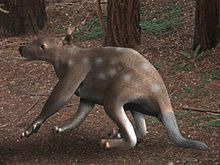
1 note
·
View note
Text

the article is from the guardian and I lost the link but here is the text
A “fluffy” crab discovered off the coast of Western Australia has been named after the ship that carried Charles Darwin around the world.
The new species, Lamarckdromia beagle, belongs to the Dromiidae family, commonly known as sponge crabs.
Crustaceans in this family fashion and use sea sponges and ascidians – animals including sea squirts – for protection. They trim the creatures using their claws and wear them like hats
Dr Andrew Hosie, a curator of crustacea and worms at the Western Australian Museum, said sponge crabs had hind legs that were specially adapted for holding their protective hats
“The sponge or ascidian just keeps growing and will mould to the shape of the crab’s back,” he said. “It will never attach … it forms a nice cap that fits quite snugly to the top of the crab.”
Similar to how hermit crabs use shells for protection, the sponges help Dromiidae crabs to camouflage from predators such as octopuses and other crabs.
The sponges can be bigger than the crab itself, and also provide a chemical deterrent. “Some of the compounds that these sponges are producing are very noxious,” Hosie said. “There’s not a lot of active predators that would be interested in munching through a sponge just to get to a crab.”
A family living in Denmark, Western Australia found a Lamarckdromia beagle specimen washed up on the beach and sent it to the Western Australian Museum for identification.
Hosie and Colin McLay, a marine biologist associated with Canterbury University in New Zealand, then described the crab as a new species – one of three sponge crabs in the Lamarckdromia genus.
‘Fluffy’ sponge crab (Lamarckdromia beagle). Photograph: Colin McLay/Courtesy of the WA Museum.
Comparing the new crab to others in the museum’s collection, they discovered several Lamarckdromia beagle specimens that were previously unidentified or misidentified. The earliest L beagle specimen they found dates from December 1925.
Hosie said it wasn’t clear why Lamarckdromia beagle was so fluffy. “The sponge or the ascidian that these things carry should offer it all the camouflage it needs,” he said. “I expect that having the extra fluffy legs means that the outline is even more obscured.”
“The hair doesn’t help with holding the sponge down. It’s not like it’s Velcro, unlike some … spider crabs that will put seaweed on their back – their hair is hooked and stiff like Velcro.”
The crab’s name commemorates the HMS Beagle, whose second voyage between 1831 and 1836 led to Charles Darwin’s theory of natural selection. The ship carried Darwin to King George Sound – the site of Albany on Western Australia’s south coast – in 1836.
“Also because it’s tanned, it’s kind of like a beagle colouration,” Hosie said.
Lamarckdromia beagle was described with other new species in a paper published in the journal Zootaxa, which detailed 31 species of sponge crab known to be found in Western Australian waters.
“Discovering new species in Western Australia is not an unusual thing,” Hosie said. “The amount of things we don’t know we’ve got in Australian waters is still very high.”
36 notes
·
View notes
Text
Spiny Lobster: Spiny and Clawless but Colorful Nonetheless
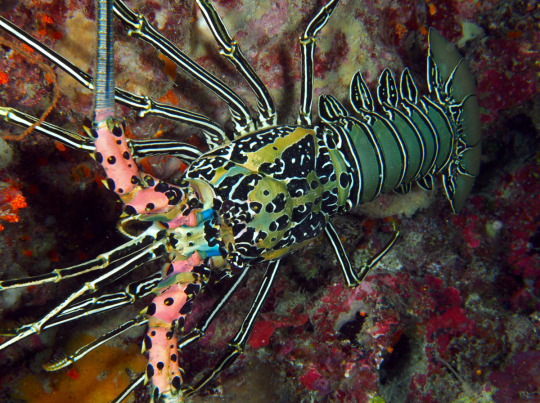
Photo from: Florent’s Guide to the Tropical Reefs
Yes, you read it right! Apparently there exists a lobster (Family Palinuridae) without claws. It may not be the one you’ve exactly imagined when you see those crustaceans whose claws are clamped in an aquarium outside a seafood restaurant but we’re pretty sure these lobsters saved the chef from some pinches. To some punctures? That we don’t know. It is named spiny lobster afterall!
I. Classification
Kingdom: Animalia
Phylum: Arthropoda
Subphylum: Crustacea
Class: Malacostraca
Subclass: Eumalacostraca
Superorder: Eucarida
Order: Decapoda
Suborder: Pleocyemata
Infraorder: Achelata
Family: Panuliridae
Genus: Panulirus
Species: versicolor (Fofonoff et. al. 2018)
II. Distribution: Hi! So my address is just right here..

Photo from: Lavery et. al. 2014
Known as the Painted Spiny Lobster, they are native to the Indo-Pacific waters and are distributed in the Red Sea, South Africa, Southern Japan, Northern Australia, Micronesia, and Polynesia. However, the first non-native occurrence is reported in the Brunswick River, Georgia (Fofonoff et. al. 2018).
III. Anatomy: Pinching for that Body Plan
Extenal Anatomy

The external anatomy of a true lobster (Family Nephropidae) is composed of two parts: The Cephalothorax and the Abdomen as depicted above. The same is true for spiny lobsters but the Paniluridae traversed a different way in the path called evolution.
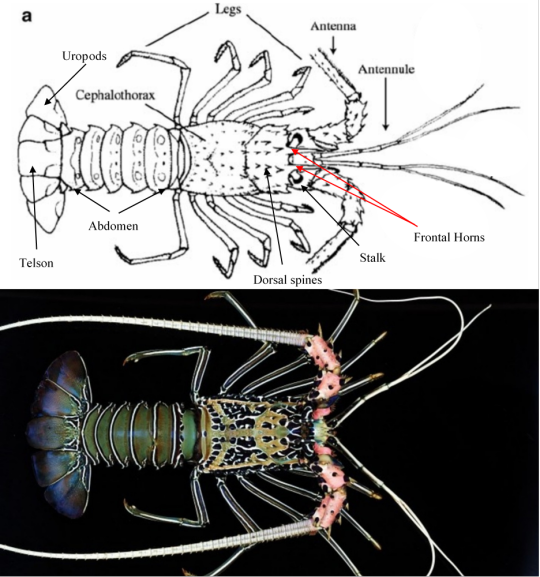
Photo from: Charles Derby 2011 (up) and Nemesis Database Species Summary (down)
So what do true lobsters have that spiny lobsters don’t? Or better yet what makes spiny lobsters unique from other lobsters?
Spiny lobsters lack the prominent claws and rostrum associated with true lobsters and instead have two frontal horns and prominent dorsal spines (Fofonoff et. al. 2018). Its body is tubular in shape with all of its legs not possessing true pincers and the first pair is not enlarged (Tavares). The antennae are cylindrical, enlarged, and longer than its body. The total body length reaches up to 400mm, but the average maximum size is around 300mm. The male spiny lobster tends to be larger than females (Fofonoff et. al. 2018).
Panulirus versicolor’s carapace has a whitish background, with large areas of bluish-black. The abdomen, on the other hand, is predominantly green in color and the telson is a mix of bluish-black and green. The legs are lined with black and blue stripes. The antenna is pinkish-red in the thicker and lower segments and becomes white ringed with black rings in the upper segment (Sutton 2017).

Photo by: Sutton 2017
The following are brief functions of the spiny lobster’s general external anatomy:
Shell: This part is the lobster’s exoskeleton, made from chitin, which serves as a protection for the internal anatomy. However, for the lobster to grow, it sheds its shell in the process called molting.
Antennae and Antennules: The antennae and antennules of the lobster are used as chemoreceptors, which detect odors and chemical signals to help them in locating food, mate, and avoid danger. In spiny lobsters, the antenna is longer than the antennules.
Stalks: For their vision, lobsters have long and stalked compound eyes. Although stalked, their vision is not that excellent, and can only see images in dim light.
Legs: Since they are under Decapoda, they have 10 legs that are used by the animal to navigate its way on the seafloor.
Tail fan: This is the last segment of the lobster. It has a telson as the center tail fin and pairs of uropods at both sides and is used for backward propulsion.
Internal Anatomy
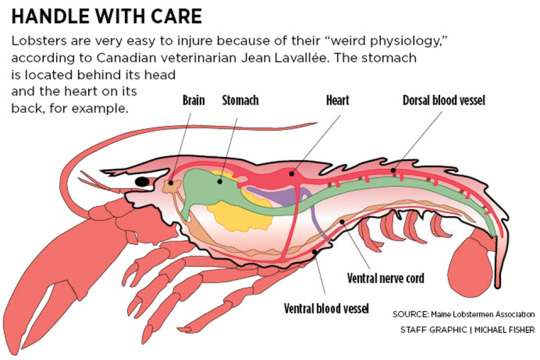
These creatures as a member of the Decapod group have internal organs that are the same as the other species. Its circulatory system is open, unlike humans. They have a single-chambered heart that is composed of muscles and ostia, or openings. Usually, the heart of an adult lobster beats for 50-136 beats per minute.
IV. Reproduction and Life Cycle
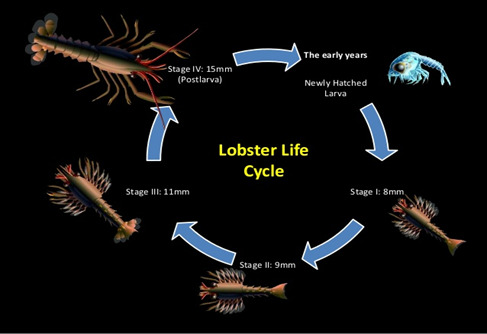
Photo from: Shiran Weerathunga, 2014
A day in a lobster’s life, they reach sexual maturity at the age of 5 to 6 years. The male’s task is to mate with as many female lobsters there is. Usually, they mate to a depth of 50 to 100 feet of water. As they mate, the male will deposit its spermatophore or known as the plaster in the female’s belly. After a while, the female will move to waters less than 30 feet deep, and when she is ready to spawn, she will use the pincers on her fifth walking leg to cut the plaster and fertilize her 80,000 to 800,000 eggs.
These eggs will be deposited under her tail, where she will perform parental duties until they hatch 9 to 10 weeks later. Usually, the larvae are transparent, large, pigmented eyes with long legs, and have little resemblance to adult lobsters. After 7 to 9 months they drift with the currents and eat plankton, after which they go to shallow water and settle at the bottom. Their lifespan is estimated to be 15 years (Cardone 2008; NOAA Fisheries 2020).
Check out this video of spiny lobsters mating!
youtube
and these cute baby lobsters!
youtube
V. Ecology
Habitat
They are found living singly or in groups in shallow water ranging from the low-tide marks up to 15 m depth and often reside in rocky areas, coral reefs, and overhangs that provide them protection (Fofonoff et. al. 2018; Mortiz 2010).

Photo by: Aquapix
Feeding Habit and Predators
Spiny lobsters are nocturnal and carnivore feeders. They even exhibit cannibalism at some point in their lives.They remain hidden in their reef or rock shelters called dens during the day and hunt during night for a variety of mollusks, shrimp, crabs, worms, and sea urchins (Sutton 2017). They use their strong legs to pry open their prey. Meanwhile, spiny lobsters are a delicacy not only to humans but octopus, groupers, and trigger fishes as well.
Be fascintaed with this video on how spiny lobsters protect themselves from a trigger fish.
youtube
VI. Relationship with Humans
Ornamental organisms
The juvenile painted spiny lobster displays a vibrant and attractive coloration of blue and purple body with white antennae which has attracted the market of tropical marine aquarium trade (Fofonoff et. al. 2018).

Photo by: Rokus Groeneveld & Sanne Rejis
For consumption
Spiny lobsters in general are eaten and are regarded as a delicacy. The meat located at the lobster’s abdomen proved to be very tasty and chewy.
youtube
While the lobster is a rich source of copper and selenium, it contains very high cholesterol, thus, it should be eaten in a regulated manner. Additionally, lobster contains zinc, phosphorus, vitamin B12, magnesium, vitamin E, and a small amount of omega-3 fatty acids (Ware 2018).
For livelihood
As of 2011, Panulirus spp. farming has not been reported in the last years to FAO but the species are cultured in Vietnam, Indonesia, Malaysia, and Philippines (Clive and Shanks 2009). Philippine waters are a natural resource of seeds for lobster farming and so there is a regional trade in peuruli and juveniles to establish spiny lobster farming.

Photo from: Mercator Media Ltd 2020
However, an article published in 2018 says that BFAR will bring the lucrative lobster culture to poor communities in Eastern Visayas by providing the cages and feeds to the beneficiaries (Meniano 2018). According to BFAR, the lobster culture is very ideal not only because of the strong demand from China and Taiwan but also because it is very expensive (4,000 per kilogram) (Meniano 2018).
VII. Did you know?
1. Lobsters pee out of their heads. While their anus is located posteriorly, their bladder is found under its brain and the opening is located at the base of their antennae, or just under their eyes!

2. The female lobster takes "her clothes off" to mate. Female lobsters “take off” their shells during molting and it is in this process that they decide to mate as well.

3. Lobsters have two stomachs. To make things even more weird, the first stomach located on its head has teeth! It functions to crush food and the second aids in digestion and is located at the abdomen.
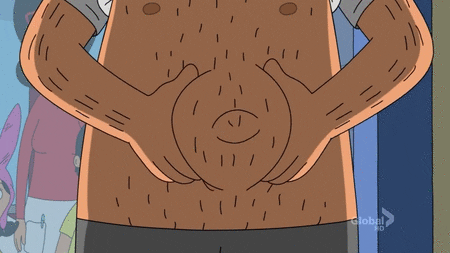
4. Lobsters can detach one of their limbs in an emergency. Don’t worry, they are able to regrow it during the molting process.(Yes, the organism in the video is a crayfish but the mechanism is the same with their lobster cousins!)
youtube
5. In the 17th century, lobster was anything but a delicacy. In fact, a field guide by Motoh from Southeast Asian Fisheries Development Center in 1980 said that the spiny lobster sells for about ₱55/kg in Manila and ₱40/kg in local areas! Now, as stated above, it costs ₱4,000/kg!
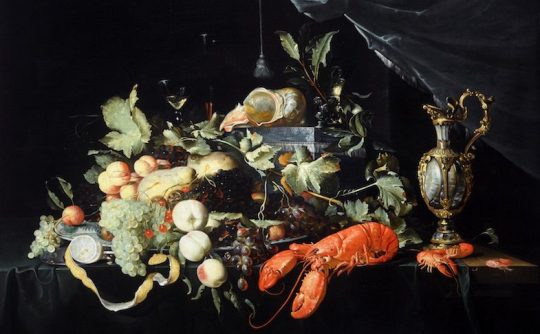
Photo from: Creative Tourist (Courtesy of Barnsley Museum)
6. The blood is known as the hemolymph and is color blue due to the presence of Copper.

Photo from: @WhatTheFFacts on twitter
VIII. References
American Lobster. (2020). Overview of Homarus americanus: The American Lobster. Retrieved November 9, 2020, from, http://www.parl.ns.ca/lobster/overview.htm
Cardone, B. (2008). The Lifecycle of Spiny Lobsters - California Diving News. Retrieved November 10, 2020, from https://cadivingnews.com/the-lifecycle-of-spiny-lobsters/
Clive, J., Shanks, S. (2009). Requirements for the aquaculture of Panulirus ornatus in Australia. Australian Centre for International Agricultural Research, 98-109
Fofonoff PW, Ruiz GM, Steves B, Simkanin C, & Carlton JT. (2018). National Exotic Marine and Estuarine Species Information System. Retrieved November 9, 2020, from, http://invasions.si.edu/nemesis/
Lavery S.D., Farhadi A., Farhamand H., Chan T.Y., Azhdehakoshpour A., Thakur V., Jeffs, A. (2014). Evolutionary Divergence of Geographic Subspecies within the Scalloped Spiny Lobster
Panulirus homarus (Linnaeus 1758). Retrieved November 9, 2020, from,DOI: 10.1371/journal.pone.0097247
Meniano, S. (2018). BFAR eyes lobster farms in 3 Eastern Visayas provinces. Retrieved from Philippine News Agency: https://www.pna.gov.ph/articles/1042610#:~:text=Lobster%20culture%20is%20very%20ideal,high%20preference%20for%20live%20lobsters.&text=A%20fishermen%20can%20raise%20up%20to%20100%20lobster%20juveniles%20in%20a%20cage.
Mortiz. (2010). Family Palinuridae - spiny lobsters. Retrieved from SealifeBase: https://www.sealifebase.ca/Summary/FamilySummary.php?ID=13
Motoh, H. (1980). FIELD GUIDE FOR THE EDIBLE CRUSTACEA OF THE PHILIPPINES. Iloilo, Philippines: SOUTHEAST ASIAN FISHERIES DEVELOPMENT CENTER (SEAFDEC) .
NOAA fisheries. (2020). Caribbean Spiny Lobster. Retrieved November 10, 2020, from https://www.fisheries.noaa.gov/species/caribbean-spiny-lobster#:~:text=Spiny%20lobsters%20may%20live%2015,3.6%20inches%20in%20the%20Caribbean.
Sutton, A. (2017). Painted Spiny Lobster – Facts and Photographs. Retrieved from Seaunseaan: https://seaunseen.com/painted-spiny-lobster-facts-and-photographs-clone/
Tavares, M. (2002). The living marine resources of the western central Atlantic. FAO Species Identification Guide for Fishery Purposes Area 51 and American Society of Ichthyologists and Herpetologists, 294-325.
Ware, M. (2018). Everything you need to know about lobster. Retrieved from Medical News Today: https://www.medicalnewstoday.com/articles/303332
#lobster#spinylobster#paintedspinylobster#Panulirus#Panulirisversicolor#Panuliridae#invertebrates aquaticinvertebrates
19 notes
·
View notes
Text
Opposum Shrimp
I. Animalia
II. Bilateria
III. Protostomia
IV. Ecdysozoa
V. Arthropoda
VI. Crustacea
VII. Malacostraca
VIII. Eumalacostraca
IX. Peracarida
X. Mysida
XI. Mysis
XII. relicta
(Taken from: Integrated Taxonomic Information System, 2005)
The Opossum Shrimp (Mysida)
Their common name opossum shrimp comes from the presence of brood pouch in females, where they carry their larvae which are not free-swimming. This crustacean is like the kangaroo of the sea!
That’s a Mysid!
The cosmopolitans
They can be found in many types of aquatic environment, in freshwater and marine, deep sea, shallow coastal waters, lakes, rivers and underground waters. Mysids are utilized commercially in Japan, Southeast Asia, China and Korea, and can be found in different marine habitats such as Pelagic, Coastal and estuarine. Worldwide, there are 160 genera and over 1000 described species. (Porter 2016; Jones 2003)

Map of stations in Southeast Asia where Mysid specimens were recorded (Sawamoto 2013)
Life Cycle
Mysid Shrimp have mechanisms that help them in mating. In some species, receptive females release pheromones in the water to attract males. Mating takes place during copulation at night, where males deposit their sperm inside the brood pouch of a female. After mating, eggs are also deposited in the brood pouch and are fertilized. Depending on the species and water temperature, females brood the eggs that take weeks to several months to hatch. Young mysids are not released until they turn into well-developed juveniles.. Mysis relicta, one of the most studied mysid shrimp found in freshwater lakes, have a 1 to 2 year life cycle depending on the productivity of the lake. Eggs of Mysis hatch into fully developed young after 3-4 months. Typical lengths are observed in each stage or instar: I – 4.5 mm, II – 9 mm, III – 12 mm, IV – 16 mm. At stage IV, individuals reach sexual maturity. Some females have a fifth instar or stage, but males do not have. Fifth instar females have 22 mm total length. (Rudstam 2009)
Anatomy
Mysids are generally small and transparent crustaceans, ranging from about 6 to 350 mm in length, where the length of the majority of species is less than 25 mm. They have a pair of stalked eyes and two pairs of antennae on their head fused with up to four of the thoracic segments, and covered with a well-developed carapace. One of their distinct characteristics is the number of their thoracic appendages, where they have six to eight. Their pereopods are biramous or separated into two branches. Also, they have a distinctive pair of statocyst located in their tail fan or uropods. Statocyst is a sac-like organ that helps them maintain their balance and provide a sense on how they can orient themselves in their environment. Their common name Opossum Shrimp comes from their distinct characteristic or feature, having a marsupium or brood pouch. This is where the Mysids keep their eggs until they hatch and are released after reaching an early juvenile stage of development. The marsupium is a chamber formed by lamellae or oostegites on all or some of the second to eighth pairs of thoracic legs. (Lenihan 2017)
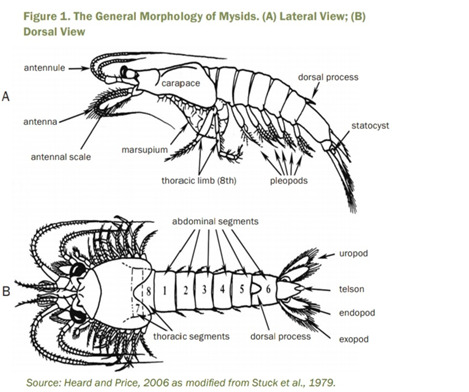
Photo from “Mysid (Americamysis bahia) Survival, Growth, and Fecundity Toxicity Tests” (EPA 2009)
Ecology
Mysids are present in almost all types of aquatic environment and are filter feeders and generally classified as omnivores, feeding on algae, detritus and zooplankton. They are very important in maintaining the balance of the aquatic ecosystem. Many fish and several species rely primarily on Mysids as their food. Mysids are rich in essential fatty acids that help in the survival of fishes. In cold regions, Mysids are a source of Polyunsaturated fatty acids that are important for fishes to have over-winter survival. Their abundance can form large shoals making them an important diet of several fish. Species like the Mysis relicta were introduced in the Kootenay lake in Canada, and it increased the growth rate and population of kokanee salmon. (Rudstam, 2009)
Sensitivity with a purpose
Mysids are very sensitive to a wide variety of contaminants. They are good indicators of harmful substances in the water. They are used as test organisms in monitoring the water quality. They are great help in wastewater management and ensuring a good quality of water in the estuarine and coastal areas since this is used in several water quality tests like the Mysid (Americamysis bahia) Survival, Growth, and Fecundity Toxicity Tests. This test is used by the U.S. Environmental Protection Agency to evaluate effluents in terms of its toxicity to biota and their impact on the natural environment. (Anderson et al. 2016; EPA 2009)
Relationship with humans
Mysids are very important especially in the aquaculture industry. They are used as food for different species of fish and a good source of nutrients for fishes being cultured like trout in the lakes of North America and Europe. Some species of Mysid are utilized as ingredients for fermented fish products. Shousuru is a Japanese fish sauce produced from fish meat added to 10% mysid, where the shrimp and mysid are used to color the sauce. (Ohshima et al. 2014)
Fun Facts
Little Cannibals
Mysids have cannibalistic behavior, where some eat weaker individuals. In fact, some parents may eat some of their babies!
Bloody Hell!
Hemimysis anomala or bloody-red shrimp is a species of Mysid Shrimp that can form reddish swarms in the shadows of piers and boats. They can spread and multiply rapidly and are considered “high-risks” for invasion of inland lakes in the US.
Invasion!
Tragic Honeymoon
After mating, male Mysid (Mysis relicta) dies and the female lives for several months. A little sacrifice for the next generation.
References:
NOAA. n.d. Great Lakes New Invader: Bloody Red Shrimp (Hemimysis anomala). GLANSIS. Rretrieved from: https://www.glerl.noaa.gov/res/Programs/glansis/hemi_brochure.html#:~:text=Mysids%20are%20often%20called%20opossum,larger%20shrimps%20and%20other%20decapods.
Sawamoto, Shozo. 2013. Current Status of Mysid Taxonomy in Southeast Asia. Researchgate.net. Available from: https://www.researchgate.net/publication/307791935_CURRENT_STATUS_OF_MYSID_TAXONOMYIN_SOUTHEAST_ASIA
Rudstam, L.G. 2009. Other Zooplankton. Encyclopedia of Inland Waters. Science Direct. Available from: https://www.sciencedirect.com/topics/agricultural-and-biological-sciences/mysis
Anderson B., Philips B. 2016. Saltwater Toxicity Test. Science Direct. Available from: https://www.sciencedirect.com/topics/biochemistry-genetics-and-molecular-biology/mysida
Jones, D.A. 2003. Characteristics of Crustacea. Science Direct. Available from: https://www.sciencedirect.com/topics/biochemistry-genetics-and-molecular-biology/mysida
Porter, M.L. 2016. Collecting and Processing Mysids, Stygiomysids, and Lophogastrids. Journal of Crustacean Biology. Available at: https://academic.oup.com/jcb/article/36/4/592/2735746
Ohshima T, Giri A. 2014. FERMENTED FOODS-Traditional Fish Fermentation Technology and Recent Developments. Science Direct. https://www.sciencedirect.com/topics/agricultural-and-biological-sciences/neomysis
Lenihan, Jamie. 2017. Opossum Shrimp. Vic High Marine. Available at: https://www.vichighmarine.ca/opossumshrimp/
EPA. 2009. Mysid (Americamysis bahia) Survival, Growth, and Fecundity Toxicity Tests. U.S. Environmental Protection Agency. Office of Wastewater Management. 1200 Pennsylvania Ave., NW Washington DC
Zooplankton of the Great Lakes. Central Michigan University. Available at: http://people.cst.cmich.edu/mcnau1as/zooplankton%20web/mysis/mysis.html
Order Mysidacea. Key to Australian Freshwater and Terrestrial Invertebrates. https://keys.lucidcentral.org/keys/v3/TFI/start%20key/key/crustacea%20key/Media/HTML/Mysidacea.html
10 notes
·
View notes
Text
Fwd: Postdoc: ULodz_Poland.CrustaceaBiodiversity
Begin forwarded message: > From: [email protected] > Subject: Postdoc: ULodz_Poland.CrustaceaBiodiversity > Date: 3 June 2022 at 05:18:06 BST > To: [email protected] > > > > Post-doc position in the project: > BIOdiversity PAtternS and Scale: the case of peracarid Crustacea from > south‑eastern Australia (BIOPASS) > > A postdoctoral position is available in the Marine Biology Research group > at Faculty of Biology and Environmental Protection, University of Lodz. > > Project: > The main objective of the project addresses the lack of fundamental > knowledge about biological diversity patterns in the benthic marine > ecosystems off the south-eastern Australian coast. This project is an > interactive approach that focuses on identification and assessing local > diversity of peracarids (Tanaidacea and Isopoda) from SE Australia to > point the environmental factors shaping the diversity over latitudinal > and bathymetric gradients. > > The project is held in University of Lodz (Poland) and forms a close > collaboration with the University of Valencia (Spain) and Melbourne Museum > (Australia). > > Candidate: > The postdoc is expected to apply methods for species delimitation > (genetic/ genomic) and testing connectivity among populations of > peracarids crustaceans from SE Australia, NW and Central Pacific, > N Atlantic. The obtained data are supposed to be interpreted with > taxonomical findings (cooperation with taxonomists) to draw the general > model of distribution (cooperation with ecologists). Finally, the genetic > results will be employed to investigate phylogeny and phylogeography of > the most diverse taxa (families/genera). > > We seek an enthusiastic candidate with good communication skills, > experience in genetics, systematic, and phylogenetics. We are looking > for geneticist who is fascinated by crustaceans or taxonomist ready to > work with small crustaceans and will to learn genetic. > > The candidate is expected to work both independently and as part of a > large research team, and may supervise technical staff and students. > > The candidate should have: Minimum PhD in biology, genetics or ecology > obtained in between 2015 (and 2022) > > The position is fully funded. It will be initially for 1 year, but > funding available to extend it further. > > If you would like to discuss the project further, > please feel free to contact with prof. Magda Błażewicz > ([email protected]). To apply, please send a CV and > cover letter stating qualifications, previous work and motivation for > the contact as above. > > > Prof. Magdalena Błażewicz > EditorPolish Polar Research > Department of Invertebrate Zoology and Hydrobiology > Faculty of Biology and Environmental Protection > University of Łódź > ul. Banacha 12/16 > 90-237Łódź > T: 42635 4297 > E:magdalena.blazewicz @biol.uni.lodz.pl > > > Magdalena Błażewicz >
via IFTTT
0 notes
Text
Hyperallergic: The Biodiversity of the World Captured in Five Centuries of Animal Art
“Bengal tiger,” watercolor by a Calcutta artist (1820) (Hastings Albums, courtesy British Library)
A Bengal tiger does not travel well, and especially didn’t in the centuries before sedation and airplanes. But 19th-century scientists in England could study its stripes from afar thanks to the international trade of art, long a vital medium for scientific understanding. The Paper Zoo: 500 Years of Animals in Art by science historian Charlotte Sleigh, out March 8 from the University of Chicago Press, is a lushly illustrated publication with 250 images from the British Library chronicling how scientific art has expressed biodiversity over the centuries.
Cover of The Paper Zoo (courtesy University of Chicago Press)
It has not always been kind. Sleigh notes that the original text for an illustration of a horned frog in George Shaw’s The Naturalist’s Miscellany (1789–1813) read: “Should inquiry be made, which is the ugliest animal yet known to exist? The creature here represented might perhaps with justice be proposed as an answer: an animal of such prodigious deformity as even to exceed in this respect the Surinam toad, or Rana Pipa.”
Sleigh divides her book into four sections: exotic, native, domestic, and paradoxical. That last is particularly colorful, filled with anecdotes about completely imaginary creatures that were assembled due to mangled word-of-mouth descriptions, and sometimes supported by enterprising individuals. “Cashing in on the craze for natural-historical collections in the early modern period, canny sailors and inhabitants of far-flung lands stitched together body parts to make salable, ‘real’ monsters,” Sleigh writes. Along with unicorns and mermaids, there is the more fantastic and terrifying “manticore” in Edward Topsell’s 1658 The History of Four-footed Beasts and Serpents. The lion-like animal has the face of a man, with three rows of grinning teeth.
Sleigh explains that “animals began to appear in medieval works of art,” often as biblical Lambs of God or one of the symbols of the evangelists (an ox, lion, or eagle). As printing developed and became widespread, animals of varying accuracy flourished in books, whether in the form of early woodcuts or later engravings. A well-depicted exotic animal was the intellectual’s prize.
Pages from The Paper Zoo (photo by the author for Hyperallergic)
Pages from The Paper Zoo (photo by the author for Hyperallergic)
“Dürer mostly produced his animal images in watercolour, and such objects, like the pictures in the collection of the Lincei, were valuable items for exchange between wealthy savants around Europe,” Sleigh writes. “In Restoration London, a painting of a lizard on vellum could command higher prices than portraits in oil executed by even the most fashionable painters.”
Naturally, there were the overachievers, including John James Audubon, who put a vibrant, life-size aviary on paper with his 19th-century Birds of America. The Paper Zoo also has glimpses of incredible naturalist voyages like those of Maria Sibylla Merian, who in 1699 set out for South America to illustrate its insects, and Ernest Haeckel, who in the 19th century created detailed drawings of microscopic animals. They had a major influence on the fluid shapes of Art Nouveau.
High-speed and high-definition photography eventually took over as a way of visually capturing wildlife in the 21st century. Still, some extinct animals like the dodo or great auk mainly survive through old illustrations. Often, though, the creator’s name is lost. “Artists are not always acknowledged — and there is even more rarely a sound grasp of the different roles played by drawers, engraves, and colourists,” Sleigh states. Below are selections from The Paper Zoo, recalling the sometimes anonymous artist’s role in five centuries of shared scientific knowledge.
Johannes Jonstonus, Historiae naturalis de insectis (Frankfurt am Main, 1650–30), illustrations by Matthäus Merian. From The Paper Zoo: “The engraver and publisher Matthäus Merian the elder was the father of Maria Sybilla Merian, although he died when she was very young. He was apparently less committed to life-drawing than his daughter, producing visual descriptions of no fewer than eight separate species of unicorn.” (courtesy the British Library)
“Purple-bellied Lory (Lorius hypoinochrous),” original watercolor, later engraved as plate 170 in George Edwards, A Natural History of Uncommon Birds, and of Some Other Rare and Undescribed Animals (London, 1743–51) (courtesy the British Library)
“Horned frog,” from George Shaw, The Naturalist’s Miscellany (London, 1789–1813). The original text with the picture asked: “Should inquiry be made, which is the ugliest animal yet known to exist? The creature here represented might perhaps with justice be proposed as an answer: an animal of such prodigious deformity as even to exceed in this respect the Surinam toad, or Rana Pipa.” (courtesy British Library)
“King penguin,” from George Shaw, Musei Leveriani explicatio Anglica et Latina (containing select specimens from the museum of the late Sir Ashton Lever, Kt., with descriptions in Latin and English) (London, 1792) (courtesy British Library)
“1. The four horned Ram, 2. Horns of the Iceland Sheep, 3. Horns of the Cretan Sheep,” from Ebenezer Sibly, An Universal System of Natural History Including the Natural History of Man, etc. (London, 1794–1807) (courtesy British Library)
“Red-bellied snake,” from George Shaw, Zoology of New Holland, the first book of Australian animals (London, 1794) (courtesy British Library)
“Ring-tailed lemur,” from George Edwards, A Natural History of Uncommon Birds, and of Some Other Rare and Undescribed Animals (London, 1743–51). From The Paper Zoo: “This picture summons up the myth of the Fall: the contemplated fruit, the lurking partner, the curling, striped, snake-like tail. There is even a banished creature disappearing off stage-left. Edwards kept a ‘Maucauco’ (as the lemur was also known) alive for a while in his home, finding it a ‘very innocent, harmless Creature, having nothing of the Cunning or Malice of the Monkey-Kind.’” (courtesy the British Library)
“Octopus,” from George Shaw, The Naturalist’s Miscellany (London, 1789–1813). From The Paper Zoo: “The ocean is understandably a source of terror, and tales of giant squid or octopuses are one way of making such fears manifest. In 1802, the French naturalist Pierre Denys de Montfort posited the existence of two such species. This example from a British book of the same era is truly the stuff of nightmares, coyly curled onto the page, but threatening to escape.” (courtesy the British Library)
“Koalas,” watercolor by unknown artist, inscribed on the back, “Coola, an animal of the opossum tribe from New South Wales,” from the Marquess Wellesley Collection of Natural History Drawings. From The Paper Zoo: “A report in the Philosophical Transactions of 1808 announced a new creature, seen a few years previously and known locally as a koala wombat. ‘The ears are short, erect, and pointed; the eyes generally ruminating, sometimes fiery and menacing; it bears no small resemblance to the bear in the fore-part of its body.’” (courtesy the British Library)
“Young Sumatran tapir,” probably by J. Briois (March 1824), gouache on paper, from an album of 51 drawings of birds and animals made at Bencoolen, Sumatra, for Sir Stamford Raffles. Raffles helped establish the Zoological Society of London and its Zoological Gardens (now London Zoo). (courtesy the British Library)
“Crab (‘Cancer dentatus’),” published in “Observations on the Genus Cancer of Dr. Leach with Descriptions of three new species” by Thomas Bell, from Transactions of the Zoological Society (London, 1835). From The Paper Zoo: “Bell devoted his life to some of nature’s less glamorous creatures, amongst them the Crustacea. In his History of the British Stalk-Eyed Crustacea, he lamented that most works of natural history lacked all but the most superficial coverage of the class. This beautifully textured illustration of an exotic species helps to remedy that situation.” (courtesy the British Library)
“Red-pied cock,” from Robert Fulton, The Illustrated Book of Pigeons (London, 1874–76). Darwin once stated that the pouter “has a much elongated body, wings, and legs; and its enormously developed crop, which it glories in inflating, may well excite astonishment and even laughter.” (courtesy the British Library)
“Dodo (‘Didus’),” from Richard Owen, Memoir of the Dodo (London, 1866). From The Paper Zoo: “Founder of the Natural History Museum (as it is known today), Owen used underhand means to make sure that he acquired the first complete dodo remains to be recovered after the bird’s extinction at the end of the seventeenth century. His Memoir came out the following year, featuring this illustration of a squat, ridiculous bird – not unlike Tenniel’s illustration of 1865 for Alice in Wonderland.” (courtesy the British Library)
“The Wild Boar,” drawing by Friedrich Specht for No. 4 in Cassell’s Natural History Wall Sheets (late 19th century) (courtesy the British Library)
Charlotte Sleigh’s The Paper Zoo: 500 Years of Animals in Art is published by the University of Chicago Press and available from Amazon and other online booksellers.
The post The Biodiversity of the World Captured in Five Centuries of Animal Art appeared first on Hyperallergic.
from Hyperallergic http://ift.tt/2lASgnR
via IFTTT
1 note
·
View note
Photo

Shy Albatrosses Thalassarche cauta are ocean nomads who roam the world's open waters effortlessly using the power of the wind. The entire population of this species breeds on three Australian islands: Albatross Island, Pedra Branca, and the Mewstone.
These animals range across the southern ocean, reaching as far as South Africa in search of their favorite foods: small fish, cephalopods, and crustacea. Shy albatrosses are currently listed as a 'Near Threatened' species by the IUCN Red List. Historically, they were exploited for their feathers, and by 1909 there were only 300 pairs left on Albatross Island.
Today, longline fishing still impacts this species but their numbers have been maintained despite this threat. They also had an avian pox outbreak on Albatross Island that has impacted their numbers slightly. Finally, the Australasian gannet, Morus serrator is this albatross' primary threat to their survival.
Learn more about the incredible marine life in our world's oceans by visiting us at: www.theterramarproject.org
Photo: JJ Harrison/Wikimedia Commons (CC BY-SA 3.0)
#oceanlife #seabirds #albatross #shy #seahope #vitaminsea #conservation #oceanminded #marinebio #naturealwayswins #oceanoptimism
0 notes
Link
Training hospitality workers to understand allergies will save lives, experts say The World Today By Tim Brunero Posted Wed at 6:20pm A line up of sesame, wheat, tree nuts, milk, peanut, fish, egg, crustacea, soy, lupin under the headline 'the usual suspects' PHOTO: National Allergy Strategy offers hospitality workers free online allergy training. (Supplied: National Allergy Strategy) RELATED STORY: What's the difference between an allergic reaction and anaphylaxis?RELATED STORY: Food allergies 'going under the radar' in children presenting with chronic illnesses MAP: Australia As the number of Australians with severe food allergies rises, so too has the number of restaurant diners suffering food-induced anaphylaxis. Key points: Fatalities from food-induced allergic reactions increasing by around 10pc each year Sufferers report having severe reactions despite warning hospitality staff about allergies New website will teach hospitality workers about prevention Fatalities from food-induced allergic reactions in Australia have been increasing by around 10 per cent each year. To combat the problem a new online training course for hospitality workers was launched today by Sydney chef Alex Herbert. The website aims to offer hospitality workers free online allergy training. Ms Herbert said cutting out cross contamination was key to lessening the number of allergic reactions, and the only way for that to happen was if chefs learnt to be aware of how they were preparing their food. "So if you're chopping nuts, [chefs think about] what board that's been done on, has that been put in the wash up? "So that you know [when] you're cutting your fish on a fresh chopping board, that when you go into the heat of service and you suddenly get a docket up that says allergy to nuts, you can safely say 'yes, I can serve this fish'
0 notes
Photo

Mengenal Nemo, Ikan Laut Yang Disebut - Sebut Koh Ahok Dalam Sidang. "Begitu terlepas, ada tidak ikan yang berterima kasih kepada Nemo yang terkapar pingsan? Tidak ada," kata Ahok. Beliau berkisah tentang suatu adegan dalam film Nemo, ketika Nemo berenang melawan arus air demi menyelamatkan temannya yang bernama Dori dan ratusan ikan lain yang terjerat dalam jaring. Namun, setelah berhasil menyelamatkan Dori dan ratusan ikan, Nemo yang pingsan tak mendapatkan ucapan terima kasih sama sekali. Begitu ya? Jadi ingat filmnya sekarang? Ikan Nemo menjadi tenar dari film animasi kisah heroik sang ayah ikan melintasi samudera untuk menyelamatkan sang anak, bernama Nemo, hingga ke perairan Australia. Lewat film ini, tidak hanya kita jadi mengenal Nemo, yang bahkan lebih dikenal dibandingkan penyebutan Clown Fish (Ikan Badut) apalagi nama marganya: Amphiprion. Tapi, kita juga jadi bisa mengenal spesies ikan lain, umur panjang penyu, crustacea yang suka bersih - bersih, East Australian Current, hingga Great Barrier Reef. Ikan Nemo hidup bersimbiosis mutualisme dengan anemon. Anemon menyediakan habitat juga terkadang makanan untuk Nemo. Dengan tentakel beracun, Anemon juga melindungi Nemo dari pemangsanya. Sang ikan di sisi lain, melindungi Anemon dari parasitnya. Nutrisi sisa metabolisme sang ikan juga dimanfaatkan oleh Anemon. Nitrogen dari sisa metabolisme Nemo juga mampu meningkatkan jumlah alga yang terakumulasi pada jaringan sang inang, membantu pertumbuhan dan perbaikan. Pergerakan oleh Nemo dalam Anemon juga dipercayai meningkatkan sirkulasi pada sang inang, yang bermanfaat antara lain dalam proses respirasi keduanya. Semua Nemo terlahir berkelamin jantan. Jenis ikan ini bersifat sekuensial Hermaprodit, dan akan berganti kelamin menjadi betina jika diperlukan. Namun, penggantian kelamin ini bersifat irreversibel, permanen, tidak dapat balik. Pergantian kelamin ini utamanya dipicu jika betina dominan sebelumnya mati, sehingga jantan pada hirarki tertinggi akan menggantikan tempatnya, menjadi betina dan mulai kawin lagi. Jadi... Jangan - jangan, sang ayah dalam film tersebut, perlu mencari Nemo sang anak agar bisa menjadi pasangan kawinnya. (at Jalan Margonda Depok)
0 notes
Text
Fwd: Postdoc: ULodz_Poland.Biodiversity
Begin forwarded message: > From: [email protected] > Subject: Postdoc: ULodz_Poland.Biodiversity > Date: 11 March 2021 at 06:14:08 GMT > To: [email protected] > > > > Post-doc Position in the project: > BIOdiversity PAtternS and Scale: the case of peracarid Crustacea from > south???eastern Australia (BIOPASS) > > A postdoctoral position is available in the Marine Biology Research group > at Faculty of Biology and Environmental Protection, University of Lodz > (Poland). > > Project: > The main objective of the project addresses the lack of fundamental > knowledge about biological diversity patterns in the benthic marine > ecosystems off the south-eastern Australian coast. This project is an > interactive approach that focuses on identification and assessing local > diversity of peracarids (Tanaidacea and Isopoda) from SE Australia to > point the environmental factors shaping the diversity over latitudinal > and bathymetric gradients. > > The project is held in University of Lodz (Poland) and forms a close > collaboration with the University of Valencia (Spain) and Melbourne Museum > (Australia). > > Candidate: > The postdoc is expected to apply a variety of methods for species > delimitation (genetic/ genomic) and testing connectivity among populations > of several hundred individuals of the peracarids crustaceans from SE > Australia, NW and Central Pacific, N Atlantic. The obtained data are > supposed to be interpret against taxonomical finding (cooperation with > taxonomists) to draw the general model of distribution (cooperation with > ecologists). Finally, the genetic results will be employed to investigate > phylogeny and phylogeograpy of most diverse taxa (family/genera). > > We seek enthusiastic candidate with good communication skills, experience > in genetic, systematic and phylogenetics. The candidate is expected to > work both independently and as part of a large research team, and may > supervise technical staff and students. > > The candidate should have: > Good interpersonal skills > Good written and oral communication skills > Experience in wet-lab molecular biology (e.g. DNA/RNA extraction, PCR) > Experience in generating transcriptomic/genomic data (e.g. RNAseq, > NGS library preparation) > Minimum PhD in biology genetics or ecology obtained in 2014 (or latter). > > The position is fully-funded. It will be initially for 1.5 years, but > funding available to extend it further. > > If you would like to discuss the project further, > please feel free to contact with prof. Magda B??a??ewicz > ([email protected]). To apply, please send a CV, > and cover letter stating qalifications, previous work and motivation > for the contact as above. > > Prof. Magdalena B??a??ewicz > EditorPolish Polar Research > Department of Invertebrate Zoology and Hydrobiology > Faculty of Biology and Environmental Protection > University of ????d?? > ul. Banacha 12/16 > 90-237????d?? > T: 42635 4297 > E:magdalena.blazewicz @biol.uni.lodz.pl > > > Magdalena B??a??ewicz >
via IFTTT
0 notes